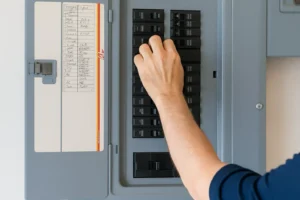Curious about household electric circuits? So are we!
At Prairie Electric, we’ve got our brains and our hands wrapped around all sorts of exciting projects. We’re happy to say that we’re busier than ever — and we’ve been around since 1981.
With a dedicated and top-notch crew of more than 200 electricians, we’re more than equipped to handle any and all residential, commercial, and utility projects that come our way.
As Vancouver’s award-winning electrical contractor (most recently, the 2018 Subcontractor of the Year by The Daily Journal of Commerce), we look forward to many years as the Pacific Northwest’s electrical contractor of choice.
Full Circuit
Which brings us right back to where we started: household electrical circuits! We thought it might be interesting for our blog’s readers to provide an overview of a common household circuit.
Many people take electrical power for granted. You switch on a light (or a microwave, or a dishwasher, or an air conditioner, or your hairdryer) and — voila! — that appliance is powered up and ready to go.
But what’s really going on behind the scenes of these everyday occurrences?
Let’s take a quick look — with the help of a few additional online resources.
Your Home’s Electrical Circuits
The first thing to focus on is the precision of the terminology. We call it an electrical circuit because the current must flow in a loop — i.e., a circuit. If the circuit is disrupted, power stops flowing.
Better Homes & Gardens has an excellent piece on how the current gets from the power company to your hairdryer.
“Power comes to your home through the power company’s transmission and distribution lines, passes through a meter and enters the service panel,” they write. “In the service panel, the power energizes two strips of metal called hot bus bars. Circuit breakers or fuses attach to the hot bus bars. Power must pass through a breaker or fuse before it leaves the service panel and goes into the house through a branch circuit. Each branch circuit supplies power to a number of outlets. An outlet is any place where power leaves the wires to provide service. Devices (receptacles and switches), ceiling lights and fans, and appliances (such as a water heater or a dishwasher) are outlets.”
That’s a lot to digest all at once, but it does a good job summarizing the process of powering your gadgets in one paragraph.
Mapping Your Circuits
Prairie Electric recommends mapping your home’s electrical circuits. HomeTips.com goes over the process and provides some important cautions, which we urge you to heed.
“Mapping your circuits is something you should do in daylight with a helper,” they write. “Be aware that all of your home’s power will be off at some point in time, so when you’re done you’ll have to reset clocks, timers, and the like. To make your mapping easier, remember that receptacles are usually on circuits separate from lighting, and major appliances such as furnaces, microwaves, washing machines, electric dryers, and electric ovens often have dedicated circuits. Note: If your electrical panel has old circuit breakers, flipping them off and on can break them, and obsolete circuit breakers may be difficult to replace.”
Wiring
Mapping your circuits helps pinpoint problem areas, but if you have zero experience with these matters, it’s best to consult an expert.
In the United States, household circuits carry a charge of about 120 volts. A household’s electric circuits carry the electrical supply to electric appliances, lights, and other items. The current travels a circuit along neutral and ground wires. These wires connect to the power grid through your service box, which in turn connects to the power lines outside your home. The neutral wire carries the current back to the source.
The wires are color-coded. This helps with identification. This also helps us avoid electric shocks and/or short-circuiting.
- White. Commonly called the neutral wire.
- Black or Red. So-called hot wires. They carry amounts of electric current from the service panel to your light, appliance, or other electronic devices.
- Bare or Green. These are your ground or earth wires — a sort of safety valve. They create a path for the electric current to return to the breaker and trip the circuit to cut off the electricity.
And then, of course, there is the concept of parallel circuits, which HowStuffWorks describes thusly: “An example of a parallel circuit is the wiring system of a house. A single electric power source supplies all the lights and appliances with the same voltage. If one of the lights burns out, current can still flow through the rest of the lights and appliances. However, if there is a short circuit, the voltage drops to almost zero, and the entire system goes down.
Prairie Electric is your best resource for electrical contracting solutions. Get in touch with us today, and we’ll get to work on whatever electrical service you need.


